Editor of this issue: Antanas Klimas, University of Rochester
Copyright © 1993 LITUANUS Foundation, Inc.

|
LITUANUS
LITHUANIAN QUARTERLY JOURNAL OF ARTS AND SCIENCES
Volume 39,
No.3 - Fall 1993
Editor of this issue: Antanas Klimas, University of Rochester ISSN 0024-5089
Copyright © 1993 LITUANUS Foundation, Inc. |

|
OTIS TAMASAUSKAS ON PRINTMAKING
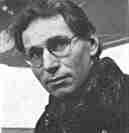
Traditionally, prints have been viewed as multiple images produced from a plate. The plate is an intermediary between the printmaker's conception and the print—a rigid. Hat surface that contains the picture or message. This message receives ink, and the inked image is transferred to the paper by pressure. The process can be repeated many times to produce nearly exact copies. For centuries this definition remained valid, but contemporary developments have stimulated a much more expansive view of the meaning of printmaking. Today a print is more likely to be defined as two- or three-dimensional image or form made by a process or combination of processes that may be repeated to produce multiple copies or even unique pieces.
As the medium itself keeps evolving, the definition of "printmaking" also seems to be constantly changing. Perhaps it would be appropriate to have a print disclosure sheet, which would include an itemized list of all processes related to printmaking. The artist would check off whatever processes were used to complete the image. By referring to the print disclosure sheet, the prospective buyer or critic could evaluate all aspects and attributes of each image produced and formulate his or her own value judgment of whether or not it is a "print."
Contemporary printmaking is a relatively young, unexplored medium which offers, I feel, much more creative latitude than painting, drawing, and/or sculpture. Printmaking truly becomes a unique visual experience with the combination of mixing the different disciplines—silkscreening, litho/ etching, etc. Here, texture and color have an opportunity to alternate, giving the artist more visual information with which to express himself/herself Artists have come to appreciate the creative possibilities of printmaking. The fact that now in contemporary printmaking most artists choose to print small editions shows, in my opinion, a more serious attitude toward the medium as a valid form of expression.
The technical developments of the past two decades have enabled artists to work with a complexity of techniques on a scale which would have been almost unimaginable twenty years ago.
This is one medium where aesthetics are in direct empathy with the techniques. I choose to work on paper. It has always offered me a range of expression, from the most sensitive fleeting ideas that would awkwardly get lost in another medium, to using the pressure of the press to permeate the paper with ink to achieve intensive color saturation, therefore treating the paper as an art form rather than as a commodity.
Ink and paper have always had an enigmatic quality for me. There's something about the power of ink—Take a pound of paint, it will spread five square yards; take a pound of ink, it will spread forty acres.
I've always felt that the work I have done has stretched the mechanical aspects to the state where the craft becomes another tool for me, the artist, using it in the service of image-making. This enables me to create a work which could be expressed in no other way.
Some people have referred to me as a "pyrotechnical maniac" but I have always subscribed to "no technique is too simple to produce impressive results in capable hands."
The term "print" is being stretched wider and wider, to include more and more disparate techniques, often for the sake of technique alone; sometimes artists lost sight of the fact that the end results either work visually or not, and no amount of technical prowess will carry a poor image.
Art and technique tend to meet when one or the other are at their best or at their worst.
Otis Tamasauskas
Otis Kazys Tamasauskas was born in 1947 in West Germany of Lithuanian parents. In 1952 he and his family immigrated to Canada, settling in Niagara Falls, Ontario, then moved to Toronto, later to Kingston, and eventually to Priceville, where he presently resides. He was educated at the Central Technical School in Toronto and the University of Windsor, Ontario, graduating in 1974 with a BFA. He continued his studies with Master Printer Don Holman in the Open Studio in Toronto, where he also taught and did custom printing in etching and lithography for professional artists. During 1977-78, he was the director of lithography at the Three Schools of Art in Toronto; during 1978-80—instructor of lithography at McMaster University, Hamilton, Ontario. Later he taught at Scarborough College, University of Toronto, and Queen's University, Kingston, Ontario. He has given numerous lectures and workshops and has exhibited his works in colleges and universities throughout Canada.
Tamasauskas is known for his sophisticated printmaking technique, as well as for the environmentalistic attitude or philosophies embodied in his work. The subjects for the most part are rivers, fish, swans, shells, salamanders, and other various figures. The inscription or title of one of his prints reads: "On the Saugeen River I met the speckled bird. He sang songs of sadness and claimed the river needs help! There was no one around."
Algimantas Kezys
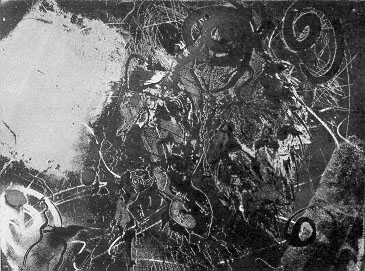
Red Salamander. Lithograph by Otis Tamasauskas.
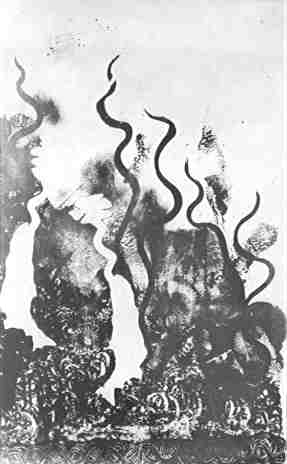
Petryla's Pond, 1973, color lithograph, 39 1/2x24 1/2
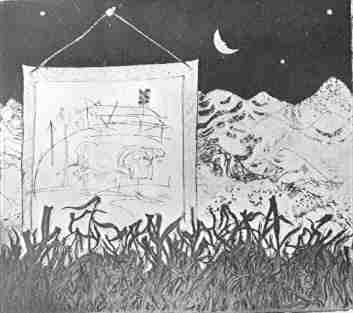
The Great Canadian Landscape, 1974, engraving, 11 1/2" x 24 1/2 "
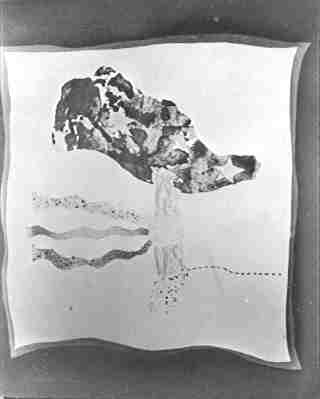
Baltic Pole, 1975, etching, 18 1/2"xl5"
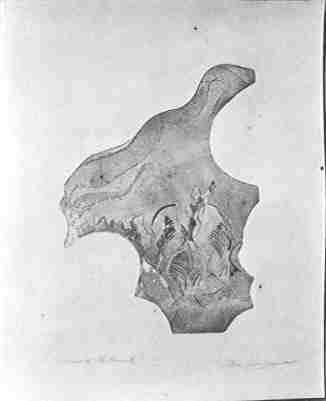
Watching of the Harvest, 1972, etching, 22"xl8"
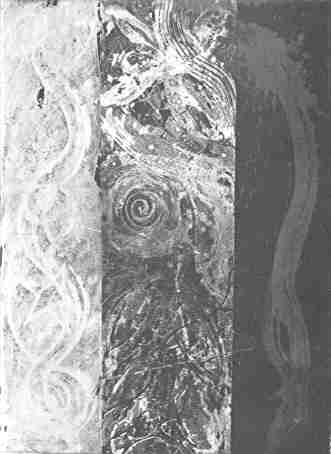
Snake, 1985, color lithograph, 39"x29"
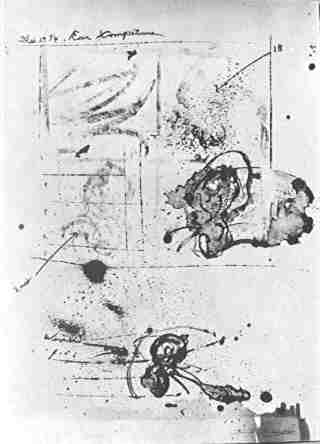
Alaskan Ear Competition, 1986, color lithograph, 30"x22 1/2"
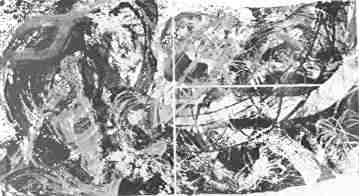
On the Saugeen River, 1988, color lithograph from broken stones, 30"x56 1/2"